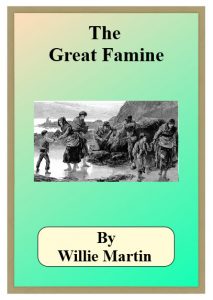THE GREAT FAMINE, ALSO KNOWN AS THE POTATO FAMINE, The Great Hunger and An Gota Mor, reduced the population of Ireland by three million people, or 36%, during the middle of the 19th century. Most of these people immigrated, but it is estimated that one million or more died of starvation and disease. While the famine was initiated by a potato blight, its actual causes are rooted much deeper in the economic system in place at the time and the attitude of the English to the people of Ireland.
Causes
The Economic system in Ireland during the early 19th century was largely an agricultural one. The country had no manufacturing centres to speak of and most of the people were subsistence farmers.
During the early 1800’s, the potato had become one of the main crops of Ireland. It was an easy crop to maintain, and gave a bountiful harvest, even greater than that of wheat. One acre of potatoes could and frequently did feed a family of five or six for the entire year. The other crops and food sources; grain, meat and dairy products were largely exported to England by landowners, where they could earn a larger profit.
The common people in Ireland, which was over one third of the population, therefore largely subsisted on potatoes, while living with their families in small one‑room shacks which dotted the countryside. Many others rented their land, or paid a rack (bed) tax to work someone else’s land or in sweat houses. Their only chance to get ahead in life was that of larger harvests, which required the use of strains of potatoes that were also susceptible to disease. By this means the stage was set for the disaster that followed.
